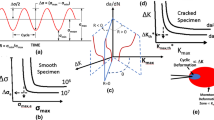Abstract
Simple procedures are presented for treating cumulative fatigue damage under complex loading history using either the Damage Curve concept or the Double Linear Damage Rule. A single equation is provided for use with the Damage Curve approach; each loading event providing a fraction of damage until failure is presumed to occur when the damage sum becomes unity. For the Double Linear Damage Rule, analytical expressions are provided for determining the two phases of life. The procedure involves two steps, each similar to the conventional application of the commonly used Linear Damage Rule. When the sum of cycle ratios based on Phase I lives reaches unity, Phase I is presumed complete, and further loadings are summed as cycle ratios based on Phase II lives. When the Phase II sum reaches unity, failure is presumed to occur. No other physical properties or material constants than those normally used in a conventional Linear Damage Rule analysis are required for application of either of the two cumulative damage methods described. Illustrations and comparisons of both methods are discussed.
Résumé
On présente des procédures simples pour traiter le dommage cumulatif par fatigue sous une histoire de contrainte complexe, en utilisant le concept de Courbe de Dommage ou de Règle de Dommage Double Linéaire. Une équation simple est fournie en vue d'être utilisée avec l'approche de la courbe de dommage: à chaque période de charge correspond une fraction du dommage jusqu'à ce que l'on prévoit que la rupture se produit dès lors que la somme des dommages de vienne égale à l'unité. Dans la règle du dommage double linéaire, les expressions analytiques ont été fournies pour déterminer les deux phases de la vie. La procédure comporte deux étapes dont chacune est similaire à l'application conventionnelle de la règle linéaire de dommage couramment utilisée. Lorsque la somme des rapports de cycles relatifs à la phase I atteint l'unité, on suppose la phase I terminée et toute charge additionellee est sommée en tant que rapport de cycle basé sur les vies de phase II. Lorsque la somme de la phase II atteint l'unité, on suppose que la rupture peut survenir. L'application de chacune des deux méthodes de dommage cumulatif décrites ne nécessite aucune autre propriété physique ou constante du matériau que celle normalement utilisée dans l'analyse conventionnelle du dommage linéaire. On discute des illustrations ainsi que des comparaisons entre les deux méthodes.
Similar content being viewed by others
References
H.J. Grover in Fatigue of Aircraft Structures, ASTM STP 274, American Society for Testing and Materials, Philadelphia (1960) 120–124.
S.S. Manson, International Journal of Fracture Mechanics 2 (1966) 327–363.
S.S. Manson, J.C. Freche, and C.R. Ensign in Fatigue Crack Propagation, ASTM STP 415, American Society for Testing and Materials, Philadelphia (1967) 384–412.
S.S. Manson, A.J. Nachtigall, and J.C. Freche, American Society for Testing and Materials, Proceedings 61 (1961) 679–703.
F.E. Richart, and N.M. Newmark, American Society for Testing and Materials, Proceedings 48 (1948) 767–800.
S.M. Marco and W.L. Starkey. American Society of Mechanical Engineers, Transactions 76 (1954) 627–632.
H.T. Corten and T.J. Dolan, Cumulative Fatigue Damage, International Conference on Fatigue of Metals, Vol. 1. Institution of Mechanical Engineers, London (1956) Paper 2 of Session 3.
S.S. Manson, Experimental Mechanics 5 (1965) 193–226.
S.S. Manson and M.H. Hirschberg, Crack Initiation and Propagation in Notched Fatigue Specimens, International Conference on Fracture, 1st, Volume 1, T. Yokobori et al., eds., Japanese Society for Strength and Fracture of Materials, Sendai, Japan (1966) 479–498.
S.S. Manson and M.H. Hirschberg, Low Cycle Fatigue of Notched Specimens by Consideration of Crack Initiation and Propagation, NASA TN D-3146 (1967).
L. Kaechele, Review and Analysis of Cumulative-Fatigue-Damage Theories, Memorandum RM-3650-PR, Rand Corporation, Santa Monica, California (1963).
J. Walcher, D. Gray, and S.S. Manson, Aspects of Cumulative Fatigue Damage Analysis of Cold End Rotating Structures, AIAA Paper 79-1190 (1979).
D. Webber and J.C. Levy, Cumulative Damage in Fatigue with Reference to Scatter of Results, Scientific and Technical Memorandum 15/58, Ministry of Supply, United Kingdom (1958).
S.S. Manson, Journal of Fatigue of Engineering Materials and Structures 1 (1979) 37–57.
JoDean Morrow, Fatigue Properties in Metals, Section 3.2, Fatiatigue Design Handbook, Advances in Engineering, Volume 4, J.A. Graham, ed., Society of Automotive Engineers, Incorporated, Warrendale (1968) 21–29.
R.W. Landgraf in Cyclic Stress-Strain Behavior-Analysis, Experimentation, and Prediction, ASTM STP 519, American Society for Testing and Materials, Philadelphia (1973) 213–228.
Author information
Authors and Affiliations
Rights and permissions
About this article
Cite this article
Manson, S.S., Halford, G.R. Practical implementation of the double linear damage rule and damage curve approach for treating cumulative fatigue damage. Int J Fract 17, 169–192 (1981). https://doi.org/10.1007/BF00053519
Received:
Revised:
Issue Date:
DOI: https://doi.org/10.1007/BF00053519




